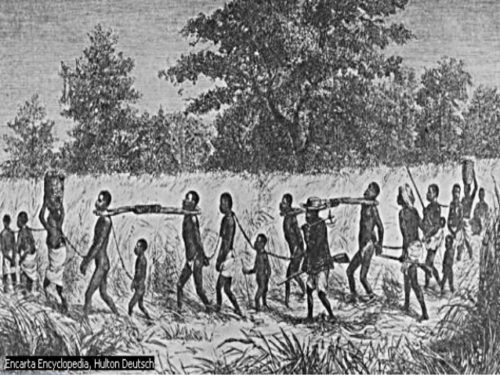Slaves in America Would’ve Been Slaves in Africa Anyway
Summary
Based on the fact that ~41% of all blacks in West and Central Africa prior to European conquest were slaves, the extreme increase in price of slaves from the relatively small increase in demand that the Atlantic Slave Trade represented, and the anecdotal evidence that more slaves were put to work within Africa following Britain’s global ban on slavery, we can say that the Europeans likely did not cause a single black person to be a slave who wasn’t already going to be one.
Outline
1. The Population of West and Central Africa 1500 to 1800
2. The Proportion of Slaves in West and Central Africa
3. The Number of Slaves in West and Central Africa
4. Atlantic Slave Disembarkations
5. The Inelasticity of Supply
6. Our Hands are Clean
The Population of West and Central Africa 1500 to 1800
Population Data on Central and West Africa
| Region | Year | Population | WAF proportion of CAF |
| West Africa | 1907 | 33.385 million | 2.606 |
| Central Africa | 1907 | 12.81 million | |
| West Africa | 1950 | 70.54 million | 2.674 |
| Central Africa | 1950 | 26.38 million |
Population Estimates for West Africa, Central Africa’s population inferred as a proportion of the West African population estimate based on the trend from 1907 to 1950:
| Region | Year | Population | WAF proportion of CAF (estimate) |
| West Africa | 1500 | 20 million | 2.361 |
| Central Africa | 1500 | 8.47 million | |
| West Africa | 1800 | 25 million | 2.453 |
| Central Africa | 1800 | 10.19 million |
Some other population estimates that will be used later based on the above extrapolations:
| Region | Year | Population | WAF proportion to CAF (estimate) |
| West Africa | 1525 | 20.42 million | 2.369 |
| Central Africa | 1525 | 8.62 million | |
| West Africa | 1866 | 30.17 million | 2.547 |
| Central Africa | 1866 | 11.85 million | |
| West Africa | 1675 | 22.92 million | 2.414 |
| Central Africa | 1675 | 9.49 million | |
| West Africa | 1775 | 24.58 million | 2.445 |
| Central Africa | 1775 | 10.05 million | |
| West Africa | 1805 | 25.08 million | 2.455 |
| Central Africa | 1805 | 10.22 million |
And so the populations of West and Central Africa as regions average to 31.83 million from 1500 to 1800.
Central Africa is defined as Chad, Cameroon, Central African Republic, Congo-Kinshasa, Congo-Brazzaville, Angola, Equatorial Guinea and Gabon.
West Africa is defined as Nigeria, Niger, Benin, Togo, Ghana, Ivory Coast, Burkina Faso, Mali, Liberia, Sierra Leone, Guinea, Guinea-Bissau, Senegal, Gambia, Mauritania.
Population of West Africa in 1500 and 1800
The Proportion of Slaves in West and Central Africa
Encyclopedia Britannica’s Guide to Black History – Slavery
Encyclopedia Britannica’s claims for the proportion of slaves in various African states
| State | Approximate Modern Location | Years | Proportion slave |
| Sokoto | Nigeria, Cameroon | “19th century” (1800-1899) | “One half” |
| Fulani Jihad States | All West Africa North of Coast | 1750-1900 | “One half” |
| Ghana | Ghana | 1076-1600 | “One third” |
| Mali | Mali | 1200-1500 | “One third” |
| Segou | Mali | 1720-1861 | “One third” |
| Songhai | Mali, Niger | 1464-1720 | “One third” |
| Ouidah | Benin | “19th century” (1800-1899) | “One half” |
| Kanem-Boru | Chad, Niger, Nigeria, Libya, Cameroon, Sudan, Central African Republic, Algeria | 1580-1890 | “One third” , “40 percent” |
| Berber-Tuareg | Sahel region | “Until 1975” | “15 percent… to perhaps 75 percent” |
| Senegambia | Senegal, Gambia | 1300-1900 | “One third” |
| Sierra Leone | Sierra Leone | “19th century” (1800-1899) | “One half” |
| Yoruba | Benin, Togo | “19th century” (1800-1899) | “One third” |
| Ashanti | Ghana | “19th century” (1800-1899) | “One third” |
| Duala | Cameroon | “19th century” (1800-1899) | “One half” |
| Ibo | Niger | “19th century” (1800-1899) | “One half” |
| Kongo | Congo | “19th century” (1800-1899) | “One half” |
| Chokwe | Angola | “19th century” (1800-1899) | “One half” |
If the estimates for the proportion of the population that are slaves are taken as precise, it averages to 41.61%.
If these numbers seem extreme, remember that Athens was said to have been about one-third slave. And the whole of the Confederate States of America was approximately one-third slave; these are not outrageous numbers for slave societies.
The Number of Slaves in West and Central Africa
So we have a good idea of what the population of West and Central Africa was, and we have consistent subjective estimates of the proportion of people that were slaves. The next question is how many people were alive in West and Central Africa from 1500-1800.
The average age of childbirth in African countries is today around 27. So if we assume the average age was 25 back in 1500-1800, then we have a generation time of 25 years.
So there were roughly 382.2 million people who lived in West and Central Africa from 1500-1800. If 41.61% were slaves, that would give us 159 million slaves within West and Central Africa between 1500 and 1800.
Atlantic Slave Disembarkations
Roughly 12.5 million slaves disembarked from Africa between 1525 and 1866 to the Americas. Over that same period, we would expect there to have been 484.63 million people to have lived in Africa, and of those 201.65 million would have been slaves between 1525 and 1866.
And so based on this, the Atlantic Slave Trade was about 5.84% of the total slave trade within West and Central Africa at the time.
The Inelasticity of Supply
Elasticity of supply is simply a fancy way of saying “does quantity supplied increase in response to an increase in demand?”. For slaves, if the supply is “elastic”, that means that the suppliers of slaves can easily supply more slaves if the demand goes up. If it is “inelastic”, that means the suppliers can’t easily get more slaves just because more people are willing to buy them.
If the supply is inelastic, then any increase in demand will simply result in the price of slaves increasing. For example, if the supply of slaves was totally fixed and could not be increased, then new buyers would simply bid out some of the previous buyers for whom slaves are now too expensive.
And here we can actually compare the price of slaves in Africa, the number of slaves shipped to the Americas in the prior 25 years (roughly the generation time), their price in Africa, and the Atlantic Slave Trade as a percentage of the overall slave trade in Central and West Africa.
Price of slaves in Africa, number of slaves shipped to the Americas, est. number of slaves in West and Central Africa, and the Atlantic Slave Trade as a proportion of the overall slave trade in West and Central Africa by year
| Year | Price of Slave IN AFRICA | Number of slaves shipped to the Americas in prior 25 years | Estimated number of slaves in West and Central Africa | Atlantic Slave Trade as proportion of overall slave trade in West and Central Africa |
| 1675 | 3.33 pounds | 0.488 million | 13.486 million | 3.492% |
| 1775 | 18.43 pounds | 1.925 million | 14.410 million | 11.785% |
| 1805 | 26.86 pounds | 2.009 million | 14.688 million | 12.032% |
Slaves shipped to Africa by year available here
Price of slaves in Africa by year available here
Now the extreme increase in price in response to the very small increase in quantity demanded that the Atlantic Slave Trade represented is evidence that Africans couldn’t readily just increase the supply of slaves. I.e. there wasn’t much or any “excess supply” with which to supply the Europeans. And so they would have to either sell some of their slaves they were already using, or pick up arms and go try to enslave some peoples who up to that point had managed to resist enslavement.
The price increases are not necessarily entirely caused by the increase in demand over those years. It’s impossible to say with any precision what caused the price increases. But the general pattern is of extreme PRICE inelasticity, with an 8.293% increase in relative quantity demanded coinciding with a 453.453% increase in price, and then a 0.247% increase in relative quantity demanded coinciding with a 45.741% increase in price.
Again, there are all sorts of factors that could be at play that I don’t know about. However, the limited data that exists points to extreme price inelasticity, which is evidence of inelasticity of quanitity supplied — which is a long way of saying “it looks like the Africans couldn’t increase the number of slaves, that the supply was fixed, and as a result when new buyers came along, the price just shot through the roof.”
According to the Encyclopedia Britannica article:
“After the limiting and then abolition of the transatlantic slave trade, a number of these African societies put slaves to work in activities such as mining gold and raising peanuts, coconuts (palm oil), sesame, and millet for the market.”
Of course that is not data, but merely a subjective impression being that the end of the Atlantic Slave Trade did not result in fewer black slaves. They just stayed in Africa.
And when ~40% of the population is enslaved, and people resist with violence being enslaved, it is certainly not difficult to imagine that the supply of slaves was probably quite inelastic.
Our Hands are Clean
The life of a slave in the Americas was certainly better than the life of a slave in Africa. It’s possible that the average non-slave African had a better life than the average slave in the Americas, but that’s not the relevant comparison.
Now lets say that the Atlantic Slave Trade did not create a single slave, that it merely moved slaves from Africa to the Americas, where they ended up having a better life and a better chance of surviving (even taking into account the middle passage, which later generations would not have to endure anyway).
Would we then say that the Europeans engaged in a wicked act? Consider that if the Europeans did not engage in this act, those slaves would have remained in Africa, where they would have been more likely to die, where their lives would have been worse — still slaves. In this case, the Atlantic Slave Trade IMPROVED their lives relative to being a slave in Africa.
And so whether or not the Atlantic Slave Trade was immoral is totally dependent on the elasticity of supply. Did the supply of slaves increase in response to the Atlantic Slave Trade, or was a relatively fixed supply of slaves simply transferred out of Africa?
And everything points to no increase in the number of Africans who were slaves. And if there was a slight increase in blacks enslaved, it is certainly less than the 12.5 million that disembarked from Africa, and exchange those 12.5 million had a better chance of surviving, and certainly their progeny had a much better life than those who remained in Africa.
We did not cause them to be slaves, nor was it our duty to buy their freedom. Nobody would be cursing Europeans if they did not buy a single slave from Africa. Yet if Europeans did not buy a single slave, those Africans would have been worse off. But by doing something that made them better off compared to inaction, Europeans are condemned as if we caused their enslavement.
The Africans were slaves to themselves well before we came along. We caused none of it, only better conditions in the Americas and their eventual freedom.
* * *
Source: The Alternative Right







Black people have ruined almost every city that they have been dominant. Detroit, Baltimore, Chicago, etc. The white race has a duty to the future generations to remove all people who want to drag down our society. We need to get together as a group and begin this process. The longer we wait, the harder it will be.
This is true, very much. However, it doesn’t change that slavery itself, whether done by white people or black people, is a bad thing. It is bad. Bad. Bad. Bad.
This is all true and easily observable to anyone who is really looking objectively.